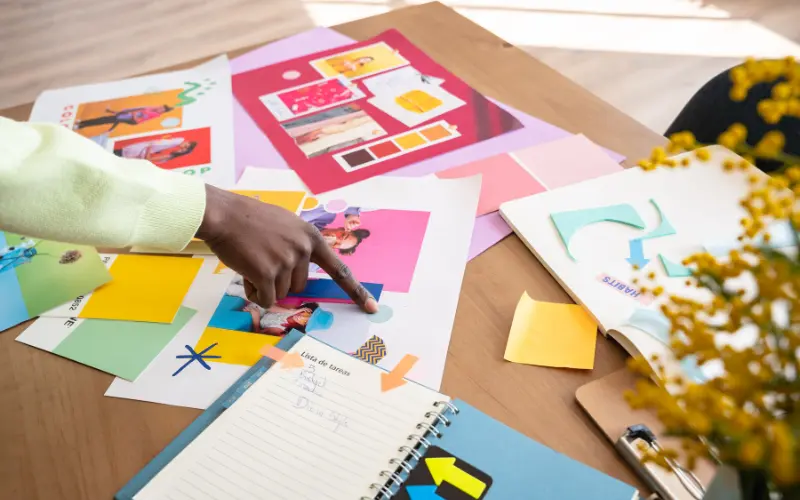In a bustling city, a small coffee shop named “Beans & Dreams” struggled to stand out amidst the sea of generic franchises. Their coffee was rich, their ambiance cozy, but something was missing.
One day, the owner, Emily, realized what it was: they had no story, no visual magic to set them apart. She embarked on a journey to weave the essence of “Beans & Dreams” into every visual aspect of her business.
From the logo that danced like steam from a hot cup to the warm, earthy colors that whispered comfort, Emily crafted a visual story that resonated with every customer who walked through the door.
This transformation wasn’t just about aesthetics but about connecting, engaging, and building a community around a cup of coffee. It’s a story that many businesses can relate to and learn from. The power of visual storytelling isn’t just about looking pretty; it’s about creating a cohesive and unforgettable brand identity that speaks to the heart of your audience.
In the world of branding, a picture isn’t just worth a thousand words; it’s worth a thousand emotions, connections, and loyal customers. Let’s delve into the magical world of visual storytelling and uncover how to create a cohesive brand identity for your business that looks good and feels right.

Section 1: What Is Visual Storytelling?
Visual storytelling is an art form that goes beyond mere images. It’s about weaving pictures, colors, shapes, and design into a narrative that encapsulates the essence of a brand.
Imagine the vivid red and curvy script of Coca-Cola, the playful, vibrant colors of Google’s logo, or the iconic swoosh of Nike. These images tell a story. They convey feelings and values and instantly tell you something about what the brand stands for.
Visual storytelling is vital in branding because it immediately connects with the audience. It’s a language that doesn’t need translation; it’s universal, engaging, and memorable. People may forget what they read but rarely what they see and feel.
The golden arches of McDonald’s or the elegant simplicity of Apple’s apple are imprinted in our minds because they tell a consistent story. This is not just design; this is visual poetry, a way to touch hearts without saying a word.

Section 2: The Importance of a Cohesive Brand Identity
Building a brand is more than creating a logo or choosing a color palette; it’s about creating an identity. A cohesive brand identity is like a consistent character in a gripping novel. It has personality, values, and a distinctive voice. It’s what makes your business unique and separates you from the competitors.
Imagine if “Beans & Dreams” had chosen a sleek, corporate look. It would have clashed with their warm, friendly vibe, confusing customers and diluting their unique story. Your brand identity should be a reflection of your core values, mission, and the promise you make to your customers.
It makes people relate to your brand, trust it, and ultimately choose it. In the following sections, we’ll explore how you can craft this essential aspect of your business, creating a cohesive brand identity that resonates, engages, and lasts.

Section 3: Steps to Create a Cohesive Brand Identity
Creating a cohesive brand identity is like painting a masterpiece. Every element must work harmoniously, reflecting your brand’s core essence.
Here’s how you can create your own work of art:
- Understanding your target audience: Dive into the minds and hearts of your customers. What do they want? What do they feel? Knowing your audience is like having a compass; it guides every decision.
- Creating a brand style guide: This is your rulebook, the direction that ensures consistency across all platforms. It includes your color palette, typography, imagery style, and tone of voice. Think of it as the recipe for your brand identity.
- Selecting consistent visuals: Consistency is key. Colors, fonts, and images must resonate with your brand’s essence. For instance, a tech startup might choose modern, clean lines, while a bakery might opt for soft, warm hues.
- The importance of logo and visual symbolism: Your logo is your brand’s face. It needs to be memorable, meaningful, and aligned with your values. The symbolism in your visuals should tell a story that resonates with your audience.

Section 4: Tips for Successful Visual Storytelling
Visual storytelling is like crafting a thrilling movie or an engaging book. It requires skill, creativity, and understanding of the audience.
Here’s how to do it:
- Storyboarding and planning: Before you create, you plan. Storyboarding helps you visualize the narrative, ensuring a smooth, logical flow.
- Aligning visuals with brand voice and values: Your visuals must echo your brand’s voice and values. For example, the imagery should reflect the commitment to sustainability if your brand is about sustainability.
- Authenticity and originality in visual content: Be honest; be you. Stock images that look like a thousand others won’t help you stand out. Invest in original content that reflects your unique identity.
The journey from understanding visual storytelling to mastering it for your brand identity is exciting, creative, and sometimes challenging. In the next section, we’ll delve into how visual storytelling translates into various aspects of your business, tying all these threads into a coherent and powerful narrative.

Section 5: More On Storyboarding and Planning
Like the director of a blockbuster movie, the storyboarding process allows you to visualize the entire narrative of your brand before creation begins. It’s like having a roadmap to success, a guided blueprint that illustrates each twist and turn of your brand’s journey.
What makes storyboarding so vital?
- Logical Flow: By sketching out the main elements of your visual story, you can ensure that each part follows logically from the last. This prevents confusion and creates a clear pathway that guides your audience through your brand story.
- Consistency: Your brand’s image and message must be consistent across all platforms and mediums. Storyboarding lets you see the big picture, ensuring that colors, fonts, and imagery are harmonized.
- Creativity and Collaboration: Having a visual plan opens up room for creativity. Experimenting with different ideas is easier when you have a solid framework. Plus, if you’re working with a team, a storyboard ensures that everyone is on the same page (literally!).
- Saves Time and Money: A well-planned storyboard helps in avoiding costly mistakes down the road. It minimizes revisions and rework by ensuring you get it right from the beginning. Time is money, especially in business, and storyboarding keeps you on track.
- Emphasizes Key Moments: Your brand’s story might have specific moments or messages that need to shine. Storyboarding helps you identify and highlight these key points, ensuring they hit home with your audience.
- Adaptation and Flexibility: A storyboard isn’t set in stone. It’s a dynamic tool that can evolve with your brand identity. The storyboard can adapt as your business grows and changes, ensuring your visual story remains relevant and engaging.
- A Communication Tool: Whether you’re working with a design team or explaining your vision to stakeholders, a storyboard acts as a visual communication tool. It translates ideas into a tangible format that others can understand and engage with.
In a world filled with noise, a cohesive and compelling visual story can make your brand identity stand out. Storyboarding isn’t just an extra step; it’s a cornerstone in building a brand that resonates. It’s where the pen meets paper, ideas turn into images, and your brand’s story begins to come alive. So grab a sketchbook, plot out your narrative, and let the magic of visual storytelling unfold.

Section 6: How Visual Storytelling Translates to Various Platforms
Visual storytelling is like a versatile actor, playing different roles across various platforms yet never losing its core essence. How do you ensure your story resonates on social media, website, or email?
Here’s the key:
- Adapting visual storytelling across platforms: Like different scenes in a movie, each platform has its own vibe and audience. Your story must adapt without losing its core message. An Instagram post might be playful, while a LinkedIn post might be more professional. Still, they all must speak the same brand language.
- Maintaining cohesion across all channels: It’s like keeping the rhythm in music. Every platform must beat to the same tune. Colors, fonts, voice – they must echo each other, providing a unified brand experience.
- Case studies of brands doing this well: Brands like Apple, Nike, and Airbnb are maestros in telling a consistent story. They adapt and engage but always stay within their core message. Studying these can offer valuable insights.

Section 7: Common Mistakes to Avoid
But wait, even the best storytellers can trip. Here are some pitfalls to watch out for in your visual storytelling journey:
- Inconsistency in design elements: Like a jarring note in a symphony, inconsistency can disrupt the flow. Whether it’s color, font, or imagery, inconsistency can confuse your audience.
- Overcomplicating visuals: Complexity can be a maze where your message gets lost. Simplicity is elegance. It’s like a clear, serene pond that reflects everything with clarity. Refrain from muddling the water with unnecessary complexities.
- Lack of alignment with the brand message: If your visuals sing a different song than your message, your audience will be perplexed. Alignment is the harmony that makes the composition complete. Always ensure your visuals resonate with your core brand message.
Mastering the art of visual storytelling is not just about being creative; it’s about being mindful, consistent, and aligned with your brand’s heart and soul. Avoid these common mistakes, and your story will not just be heard but remembered and cherished. The following section will tie everything together, giving you a roadmap to create a brand identity that is seen and felt.

Conclusion
Lights, camera, action! You’re the director of your brand’s visual story, and it’s time to take center stage. We’ve traveled through the world of visual storytelling, uncovering its immense importance in sculpting a memorable and cohesive brand identity. It’s about connecting the dots, painting a picture, and telling a tale that resonates with your audience’s heart and soul.
Think of your favorite movie. What made it stick with you? The visuals, the storyline, the consistency? That’s the magic you can weave into your brand with a professional touch. Imagine the transformation, the leap from being one of the many to stand out as the one. It’s all about the story you tell and how you tell it.
So, my friend, is your brand ready to star in its own blockbuster? Here at Launch House Co., I don’t just design; I craft stories. I create experiences. Every brand is a unique tale, and I bring passion, creativity, and a bespoke approach to every project. I want to help you tell your story and to tell it right.
Feel like chatting over a virtual coffee? Reach out, and let’s explore the uncharted territories of your brand’s visual universe together.
Remember, the difference between a forgettable brand and a memorable one is often a well-told visual story. So, grab your script, pull up a chair, and let’s launch your brand into a world where it doesn’t just survive; it thrives.
Let’s make your visual story not just a fleeting glance but an enduring impression. Let’s make it unforgettable.
